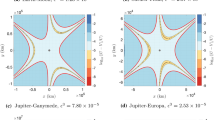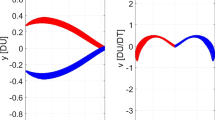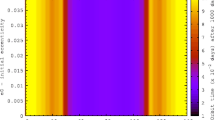Abstract
It is desirable to design low-altitude and near-polar science orbits for missions to Galilean moons. However, the long-term perturbation from a distant perturber may lead such a kind of orbits to quick impacts, indicating that initial conditions of working orbits need to be well-designed. To this end, long-lifetime working orbits around oblate satellites are investigated in this work. Initially, numerical maps of lifetime around oblate satellites are produced under the long-term dynamical model and they show that initial conditions of long-lifetime orbits are distributed in the form of strips in the space spanned by initial longitude of ascending node and argument of pericenter. This phenomenon is known to be caused by the effect of nodal phasing due to the existence of the mother planet’s obliquity. To understand the mechanism of nodal phasing, we adopt Lie-series transformation to formulate an integrable Hamiltonian model, where the dynamical structures in phase space can be uncovered by phase portraits. Furthermore, we provide three constraints for solving the initial conditions of long-lifetime orbits: the first one states that the Hamiltonian of long-lifetime orbits should be equal to that of the stable manifold, the second and third ones are associated to given initial eccentricity and inclination. By solving these constraint equations and performing direct transformation, analytical strips are produced. It is shown that the analytical and numerical strips are in good agreement. At last, the analytical approach is applied to missions to Galilean moons.












Similar content being viewed by others
Data availibility
The data and codes are available upon request.
References
Beaugé, C., Nesvornỳ, D., Dones, L.: A high-order analytical model for the secular dynamics of irregular satellites. Astron. J. 131(4), 2299 (2006). https://doi.org/10.1086/500048
Broucke, R.A.: Long-term third-body effects via double averaging. J. Guid. Control. Dyn. 26(1), 27–32 (2003). https://doi.org/10.2514/2.5041
Campbell, J.A., Jefferys, W.H.: Equivalence of the perturbation theories of Hori and Deprit. Celest. Mech. 2(4), 467–473 (1970). https://doi.org/10.1007/BF01625278
Carvalho, J., Santos, J.C., Prado, A., et al.: Some characteristics of orbits for a spacecraft around Mercury. Comput. Appl. Math. 37, 267–281 (2018). https://doi.org/10.1007/s40314-017-0525-y
Cinelli, M., Ortore, E., Circi, C.: Long lifetime orbits for the observation of Europa. J. Guid. Control. Dyn. 42(1), 123–135 (2019). https://doi.org/10.2514/1.G003652
Cinelli, M., Lei, H., Ortore, E., et al.: Probe lifetime around natural satellites with obliquity. Astrodynamics 6(4), 429–439 (2022). https://doi.org/10.1007/s42064-022-0145-1
Cinelli, M., Ortore, E., Circi, C., et al.: Science orbits with an inner disturbing body and an outer disturbing body. J. Guid. Control Dyn. (2023). https://doi.org/10.2514/1.G007224
Cook, G.E.: Luni-solar perturbations of the orbit of an earth satellite. Geophys. J. Int. 6(3), 271–291 (1962). https://doi.org/10.1111/j.1365-246X.1962.tb00351.x
Daquin, J., Rosengren, A.J., Alessi, E.M., et al.: The dynamical structure of the MEO region: long-term stability, chaos, and transport. Celest. Mech. Dyn. Astron. 124, 335–366 (2016). https://doi.org/10.1007/s10569-015-9665-9
Deprit, A.: Canonical transformations depending on a small parameter. Celest. Mech. Dyn. Astron. 1(1), 12–30 (1969). https://doi.org/10.1007/BF01230629
Deprit, A., Henrard, J., Price, J., et al.: Birkhoff’s normalization. Celest. Mech. 1(2), 222–251 (1969). https://doi.org/10.1007/BF01228842
Dragt, A.J., Finn, J.M.: Lie series and invariant functions for analytic symplectic maps. J. Math. Phys. 17(12), 2215–2227 (1976). https://doi.org/10.1063/1.522868
Gkolias, I., Daquin, J., Gachet, F., et al.: From order to chaos in earth satellite orbits. Astron. J. (2016). https://doi.org/10.3847/0004-6256/152/5/119
Gkolias, I., Lara, M., Colombo, C.: An ecliptic perspective for analytical satellite theories. Astrodynamics 167, 337–351 (2019)
Hori, G.I.: Theory of general perturbation with unspecified canonical variable. Publ. Astron. Soc. Jpn. 18(4), 287 (1966)
Koseleff, P.V.: Comparison between Deprit and Dragt–Finn perturbation methods. Celest. Mech. Dyn. Astron. 58(1), 17–36 (1994). https://doi.org/10.1007/BF00692115
Kozai, Y.: The motion of a close earth satellite. Astron. J. 64, 367 (1959). https://doi.org/10.1086/107957
Kozai, Y.: Secular perturbations of asteroids with high inclination and eccentricity. Astron. J. 67, 591–598 (1962). https://doi.org/10.1086/108876
Kudielka, V.: Equilibria bifurcations of satellite orbits (1997). https://doi.org/10.1007/978-94-011-5510-6_17
Lara, M.: Simplified equations for computing science orbits around planetary satellites. J. Guid. Control. Dyn. 31, 172–181 (2008). https://doi.org/10.2514/1.31107
Lara, M.: Hamiltonian perturbation solutions for spacecraft orbit prediction. De Gruyter, Berlin, Boston (2021). https://doi.org/10.1515/9783110668513
Lara, M.: On perturbation solutions in the restricted three-body problem dynamics. Acta Astronaut. 195, 596–604 (2022). https://doi.org/10.1016/j.actaastro.2022.01.022
Lara, M., Juan, J.F.S.: Dynamic behavior of an orbiter around Europa. J. Guid. Control. Dyn. 28(2), 291–297 (2005). https://doi.org/10.2514/1.5686
Lara, M., Russell, R.: Computation of a science orbit about Europa. J. Guid. Control. Dyn. 30(1), 259–263 (2007). https://doi.org/10.2514/1.22493
Lara, M., San-Juan, J.F., Ferrer, S.: Secular motion around synchronously orbiting planetary satellites. Chaos 10(1063/1), 2038547 (2005)
Lara, M., Russell, R., Villac, B.: Classification of the distant stability regions at Europa. J. Guid. Control. Dyn. 30(2), 409–418 (2007). https://doi.org/10.2514/1.22372
Lara, M., Jesús, F.P., Patricia, Y., et al.: Analytical theory for spacecraft motion about Mercury. Acta Astronaut. 66(7), 1022–1038 (2010). https://doi.org/10.1016/j.actaastro.2009.10.011
Lara, M., San-Juan, J.F., López, L.M., et al.: On the third-body perturbations of high-altitude orbits. Celest. Mech. Dyn. Astron. 113, 435–452 (2012). https://doi.org/10.1007/s10569-012-9433-z
Lei, H.: A semi-analytical model for secular dynamics of test particles in hierarchical triple systems. Mon. Not. R. Astron. Soc. 490(4), 4756–4769 (2019). https://doi.org/10.1093/mnras/stz2917
Lei, H., Circi, C., Ortore, E.: Modified double-averaged Hamiltonian in hierarchical triple systems. Mon. Not. R. Astron. Soc. 481(4), 4602–4620 (2018). https://doi.org/10.1093/mnras/sty2619
Lei, H., Circi, C., Ortore, E., et al.: Quasi-frozen orbits around a slowly rotating asteroid. J. Guid. Control. Dyn. 42(4), 794–809 (2019). https://doi.org/10.2514/1.G003837
Lei, H., Ortore, E., Circi, C.: Secular dynamics of navigation satellites in the MEO and GSO regions. Astrodynamics (2022). https://doi.org/10.1007/s42064-021-0110-4
Lidov, M.L.: The evolution of orbits of artificial satellites of planets under the action of gravitational perturbations of external bodies. Planet. Space Sci. 9(10), 719–759 (1962). https://doi.org/10.1016/0032-0633(62)90129-0
Lidov, M.L., Yarskaya, M.V.: Integrable cases in the problem of the evolution of a satellite orbit under the joint effect of an outside body and of the noncentrality of the planetary field. Cosmic Res. 12, 139 (1974)
Luo, L., Katz, B., Dong, S.: Double-averaging can fail to characterize the long-term evolution of Lidov–Kozai Cycles and derivation of an analytical correction. Mon. Not. R. Astron. Soc. 458(3), 3060–3074 (2016). https://doi.org/10.1093/mnras/stw475
Morbidelli, A.: Modern celestial mechanics: aspects of solar system dynamics. Taylor & Francis, London and New York (2002)
Murray, C.D., Dermott, S.F.: Solar System Dynamics. Cambridge University Press, Cambridge (1999). https://doi.org/10.1017/CBO9781139174817
Paskowitz, M.E., Scheeres, D.J.: Design of science orbits about planetary satellites: application to Europa. J. Guid. Control. Dyn. 29(5), 1147–1158 (2006). https://doi.org/10.2514/1.19464
Russell, R.P., Brinckerhoff, A.T.: Circulating eccentric orbits around planetary moons. J. Guid. Control. Dyn. 32(2), 424–436 (2009). https://doi.org/10.2514/1.38593
San-Juan, J.F., Lara, M., Ferrer, S.: Phase space structure around oblate planetary satellites. J. Guid. Control. Dyn. 29(1), 113–120 (2006). https://doi.org/10.2514/1.13385
Scheeres, D., Guman, M., Villac, B.: Stability analysis of planetary satellite orbiters: application to the Europa Orbiter. J. Guid. Control. Dyn. 24(4), 778–787 (2001). https://doi.org/10.2514/2.4778
Zharkov, V.N., Karamurzov, B.S.: Models, figures, and gravitational moments of Jupiter’s satellites Io and Europa. Astron. Lett. 32(7), 495–505 (2006). https://doi.org/10.1134/S1063773706070073
Acknowledgements
All authors wish to thank anonymous reviewers for their helpful suggestions that improved the quality of this manuscript. This work is supported by the National Natural Science Foundation of China (Nos. 12073011 and 12233003) and the National Key R &D Program of China (No. 2019YFA0706601).
Author information
Authors and Affiliations
Corresponding author
Ethics declarations
Conflicts of interest
The authors declare that they have no Conflict of interest.
Additional information
Publisher's Note
Springer Nature remains neutral with regard to jurisdictional claims in published maps and institutional affiliations.
Appendix A Detailed expressions of \({{\mathcal {K}}}\)
Appendix A Detailed expressions of \({{\mathcal {K}}}\)
It is noted that \({{{\mathcal {K}}}}_3\) and higher-order Kamiltonian are too long, so they are not explicitly presented here.
Rights and permissions
Springer Nature or its licensor (e.g. a society or other partner) holds exclusive rights to this article under a publishing agreement with the author(s) or other rightsholder(s); author self-archiving of the accepted manuscript version of this article is solely governed by the terms of such publishing agreement and applicable law.
About this article
Cite this article
Zhao, S., Lei, H., Ortore, E. et al. Analytical investigation about long-lifetime science orbits around Galilean moons. Celest Mech Dyn Astron 136, 14 (2024). https://doi.org/10.1007/s10569-024-10183-6
Received:
Revised:
Accepted:
Published:
DOI: https://doi.org/10.1007/s10569-024-10183-6




